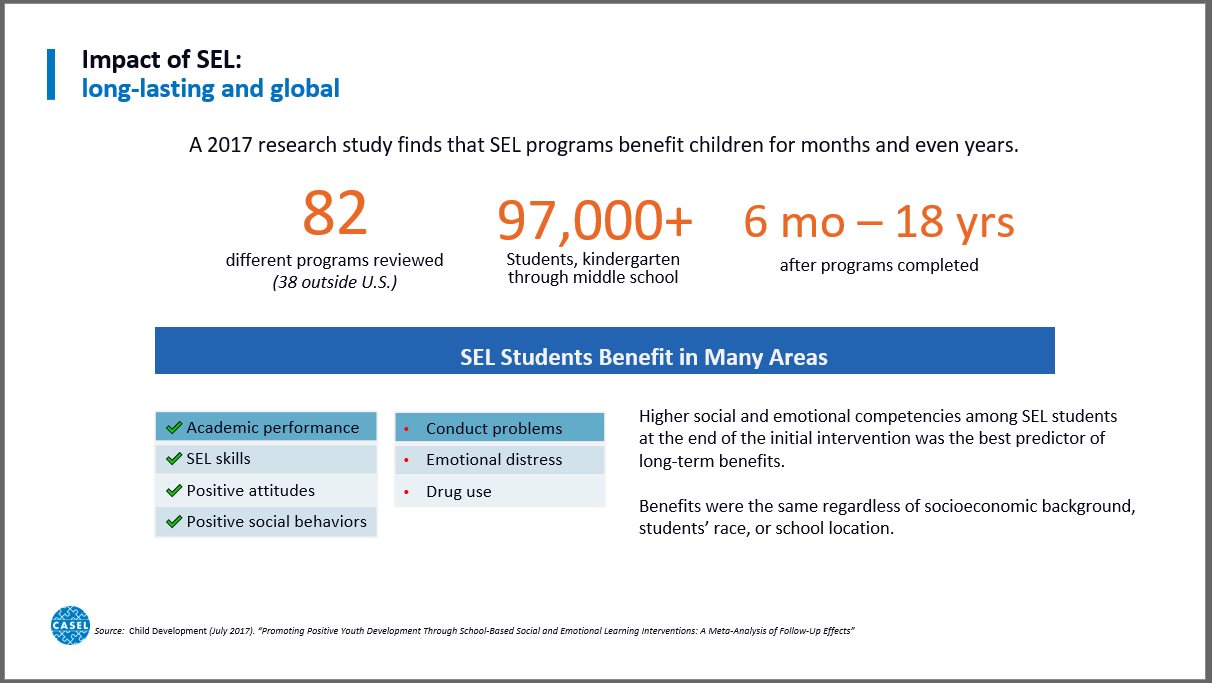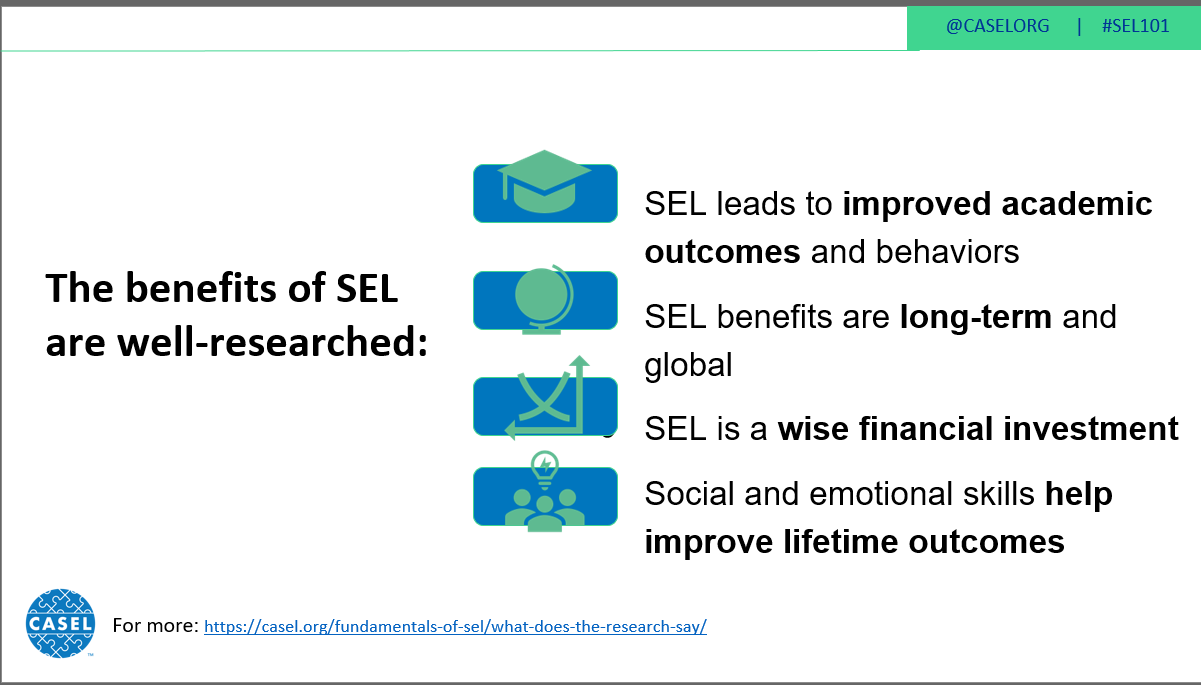Social and Emotional Learning
Skills to Build and Implement
Systemic Implementation
A systemic approach ensures that SEL is woven into all students’ educational experiences. More than a single lesson or activity, SEL is integrated across key settings where students live and learn: classrooms, schools, homes, and communities. It also aligns school district and state policies, resources, and actions to support SEL. Federal policies play a role in creating ripe conditions for supportive environments and rich learning experiences. Casel.org
Our Whole School Approach
Combining methods for spectacular results
Our approach is an intentional mix of proven research methods, academic learning, and documented experiences to empower principals and classroom teachers to bring the very best to implementing specific Social and Emotional Learning skills.
We rely on the experts at CASEL.org to provide the most up-to-date language and information about how and why an SEL culture change is right for your school, right now. They offer many different kinds of resources that detail the scientific research showing the first and best steps to integrating SEL on a level that is right for your school.
Research and Skill Building Results
Bringing the arts to the classroom works for everyone
John F. Kennedy Center for the Performing Arts :
"An approach to teaching in which students construct and demonstrate understanding through an art form. Students engage in a creative process which connects an art form and another subject and meets evolving objectives." According to the Kennedy Center, this can occur in three ways:
Arts as the curriculum, which is when students study specific art forms, typically within classes.
Arts- enhanced curriculum, which focuses on the arts as a way to enhance or explore a curricular concept. This form of arts integration doesn’t require teachers to have specific training in the different arts forms.
Arts- integrated curriculum, which is where the arts are the method for exploring the curriculum. In this style, lessons may have dual objectives that include the art form and the content knowledge.
Multiple studies have shown that various models of arts integration improve students’ long-term retention of content(1,2). In the schools and classrooms where the arts are being used to teach the curriculum, students are more likely to remember what they learned weeks and months later.
The Kennedy Center also cites research that points to benefits for teachers, such as an increase in teacher satisfaction, and an increase in a sense of community within the school. At a time when teacher retention is at a low and most states are facing teacher shortages, an approach to teaching that will enhance teacher satisfaction while also boosting student retention of content and non-academic skills seems like a good investment of time and resources.
References
1. Rinne L, Gregory E, Yarmolinskaya J, Hardiman M. Why Arts Improves Long-Term Retention of Content. Mind, Brain, Educ. 2011;5(2):89–96.
2. Hardiman M, Rinne L, Yarmolinskaya J. The Effects of Arts Integration on Long-Term Retention of Academic Content. Mind, Brain, Educ. 2014;8(3):144–8.
3. Diamond A. Activities and Programs That Improve Children’s Executive Functions. Curr Dir Psychol Sci. 2012;21(5):335–41.
4. Steel JS. Noncognitive factors in an elementary school-wide arts integrated model. 2016;12(1).
The Best SEL Tools Are the Arts
Teaching Artists are key to culture change
Who is a Teaching Artist?
There’s not one definition, but a teaching artist (TA) is a two-career professional: an artist and an educator.
Eric Booth has said, “A teaching artist is a practicing professional artist with the complementary skills and sensibilities of an educator, who engages people in learning experiences in, through, and about the arts.”
We primarily use Theatre Arts as the foundation and vehicle to begin small ripple changes. Theatre, in and of itself, is a collaborative effort that only succeeds when everyone shares a common vision and are willing to try a variety methods to make that vision come to life. The 4-C Learning method is derived from the hardwork, defined language, and flexibility that this art form demands. We also love collaborating with fine artists, writers, speakers, and scientsists to add in the extra-special educational experience.
Creating culture change and redefining community structures can seem to be an overwhelming task, but the step-by-step approach based on thousands of years of theatre history behind us, combined with the lastest scientific research is the easiest way to get almost anyone on board to create a better near-future.
We know that kids are naturally playful, fidgety, and looking for ways to engage with the classroom instructor that doesn't just include sitting at desk or a behind a screen. We know that many teachers feel as though they are caught in district-required mandates that can make lesson planning difficult, but we also know that teachers are craving a new way to present lessons while making sure they benchmarks are met.
We have created a paradigm shift in bringing specific SEL needs to the entire school microcosm
Bring Theatre Arts To the Classroom
Enhancing lessons by involving students and teachers in real time
Whether you're a science teacher trying to get kids to remember the solar system, or a language arts teacher struggling with bringing vocabulary lessons alive, or need help with a history topic that makes senstive explanations a little easier, incorporating our Theatre Arts Workshops or Residencies are the key to engaging not only students, but teachers in the real-time learning process. Often when guest artists come into a school or classroom, teachers and educators can feel like this extra human is replacing teaching time and look forward a break or an opportunity to get some other work done, but with the Whole School SEL approach, we include and devise the lesson plan with the teacher as the leader of the classroom.
We know that your relationships with students are valuable and rely on your day-to-day expertise to tailor lesson enhancement to ensure maximum learning, while having a lot of fun. We always focus on delivering social and emotional skills as the underlying teaching tool using the 4-C Learning Method.
Calm Body, Calm Brain is the foundation from which true learning can blossom. We learn and apply the Ten Breaths Away breathing method to train our brain to be mindful and practice reducing anxiety in the body.
Communication is key and derived with Trauma Informed and Non-Violent Communication Techniques: we are creating a respectful dialogue with adults in the room to ensure appropriate modeling behavior.
Collaboration is demonstrated by meeting with your Theatre Teaching Artist and the classroom teachers and paras/aides to define desired outcomes and creating the lessons together; active teaching time models appropriate ability to communicate and make corrections to students.
Self-Confidence is a natural result of bringing the arts intentionally to the classroom, particularly Theatre Arts. We strive to instill confidence in working with classroom teachers to try out new and fun techniques without fear of judgment by others - just think if you're the Sun and your students revolve around you, even if just for one class period! By demontrating that you're willing to get out of your comfort zones, students will naturally begin to let their own inhibitions go. Soon the entire classroom feels like an afterschool program or a daycamp experience - and teachers are needed to join in on the fun!
Bring Theatre Arts to School Hallways and Beyond
Create true change by involving every adult
We know that the buy-in needed to effect true change in any ecosystem is that everyone feels that they are empowered and a part of the new social fabric. That's why we provide training and resources for every adult who works or volunteer in a school setting. Much of this training is based on the foundation of theatre principles because they just work.
We focus on the 3-C Learning Method that empowers everyone to do their best, ask questions, and receive real feedback that helps to strengthen the community.
Sometimes language changes can feel uncomfortable or unusual to use (like when everything became "sus" in past couple of years!), but this creates a way to change the common groundwork and expectations for communication styles. We do this by weaving social and restorative justice into each interaction, so that we are always demonstrating our respectful best.
Sometimes our comfort in previously created communities causes a certain resistance to breaking up a way of doing things, even if they cause pain or harm. We provide a new framework for collaborative experiences that relies on tried-and-true experiences, along with new techniques we've created along the way.
Sometimes a shift in the way we do things can be a shake to our confidence and we need some help rebuilding that muscle. Our Theatre Teaching Artists are experts and creating the kind of comfort that allows anyone to shine, both inside and out.

